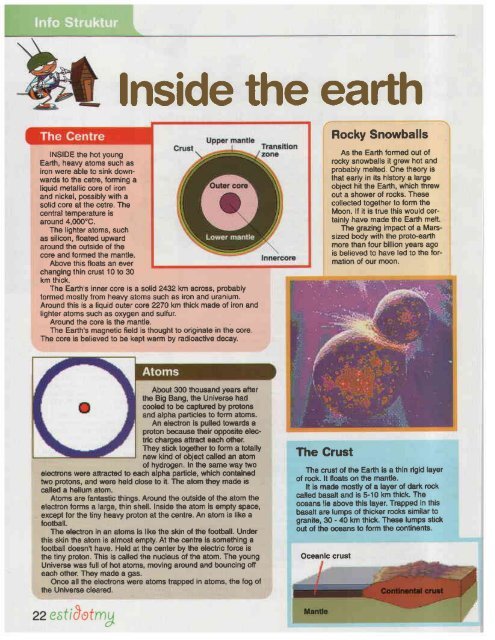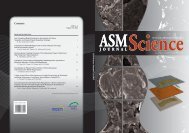Suntikan Baru ICT Negara - Akademi Sains Malaysia
Suntikan Baru ICT Negara - Akademi Sains Malaysia
Suntikan Baru ICT Negara - Akademi Sains Malaysia
You also want an ePaper? Increase the reach of your titles
YUMPU automatically turns print PDFs into web optimized ePapers that Google loves.
fnside the earth<br />
lNslDE ths hot young<br />
Earth, haavy atoms such as<br />
iron were able to sink downwards<br />
lo the cetre, foming a<br />
liouid metalli coro of iron<br />
and nickel, possibly with a<br />
solid core at the cetre. Ths<br />
central tomoerature is<br />
around 4,00O'C.<br />
The lighter atoms, such<br />
as silicon, tloated upward<br />
around th6 outside of lhe<br />
core and formed the mantle.<br />
Above this floats an ever<br />
changing thin crust 10 to 30<br />
km thick.<br />
The Earth's inner core is a solid 2432 km across, probably<br />
lormed mostly from heavy atoms such as iron and uranium.<br />
Around this is a liouid outer core 2270 km thick made of iron and<br />
lighter aloms such as orygen and sulfur.<br />
Around lhe core is lhg mantle.<br />
The Earth's magnetic field is lhoughto originate in the core.<br />
The core is believed to be kepl warm by radioactive decay.<br />
Rocky Snowballs<br />
As the Earth formed out of<br />
roclq snowballs it glow hot and<br />
probably melted. One theory is<br />
that early in its history a large<br />
obtecr hit the Earth, which threw<br />
out a shower of rocks. These<br />
collected logether to torm lhe<br />
Moon. ll il is true this would certainly<br />
havs made the Earlh melt.<br />
The grazing impact ol a Marssized<br />
body with the proto-earth<br />
more than lour billion years ago<br />
is believed to have lsd to the tormation<br />
of our moon.<br />
About 300 thousand ygars atl€r<br />
ths Big Bang, the Universe had<br />
cooled lo be captured by protons<br />
and alpha particlss lo iorm atoms.<br />
An elsctron is pull€d towards a<br />
proton because their oppositg 9l6ctric<br />
cfiarges attract each olher.<br />
They stick tog€thsr to form a totally<br />
n€w kind of object callod an atom<br />
ol hydrogen. In the same way two<br />
slectrons were altracrtad to each alpha particle, whlch contained<br />
two protons, and wer€ hsld doss to it. The alom lhey mad€ is<br />
called a h€lium atom.<br />
Atoms are tantastic things. Around the oulsids ol the atom the<br />
€lectron forms a lafgo, thin sh6ll. Insid€ ths alom is smpty space,<br />
except for the tiny heavy proton at ths csntre. An atom is like a<br />
lootball.<br />
The electron in an atoms is like tha skin of lh€ foolball. Undor<br />
this skin the atom is almost smpty. At lhs c€ntre is somothing a<br />
football doesn't have. Hsld at the center by lho olectric lorc€ is<br />
the tiny proton. This is called the nusleus of the atom- Ths young<br />
Universe was tull of hol atoms, moving around and bouncing off<br />
each olhs( They made a gas.<br />
Onc€ all lhe el€ctrons were atoms trapped in aloms, the fog ot<br />
the Universo cieared.<br />
zzesti}otmq<br />
o<br />
The Crust<br />
The crust of th6 Earth is a thin dgid layer<br />
of rock. lt ffoats on lhg mantle.<br />
It is made mostly of a layer of dark rock<br />
called basalt and is 5-10 km thick. The<br />
oceans lie above this layer. Trapped in this<br />
basalt are lumps ol thicksr rocks similar to<br />
granite, 30 - 40 km thick. These lumps stick<br />
orjt of the oceans to form lhe @ntinents.<br />
Oceanlc crust

















